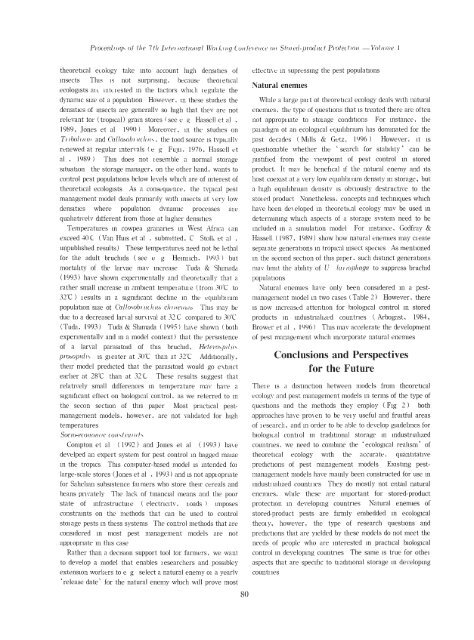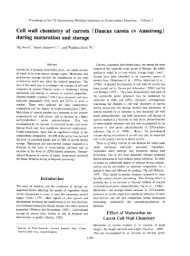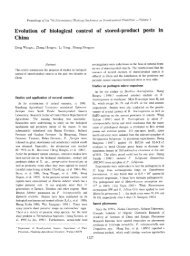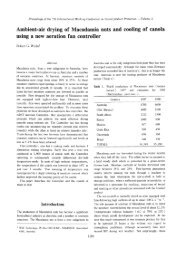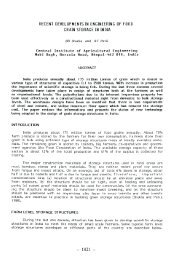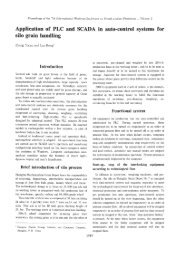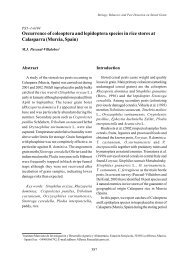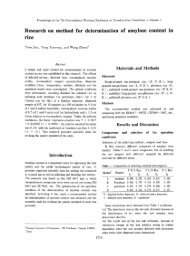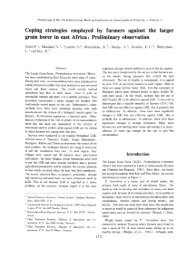72-87 - SPIRU Index Page
72-87 - SPIRU Index Page
72-87 - SPIRU Index Page
You also want an ePaper? Increase the reach of your titles
YUMPU automatically turns print PDFs into web optimized ePapers that Google loves.
Pvoceedruq- 0/ tin' Til: Iutei uatiouo! Wl!lhlllg Coutevence Oil Sttn ed-proli«t Protect ion - Yoiun,« 1<br />
theoretical ecology take into account high densities of<br />
insects Tlus IS not surpnsmg , because theoretical<br />
ecologists au, inu rested m the tactors wluch regulate the<br />
dynamic size ot a population However, in these studies the<br />
densities of insects are generally so high that they are not<br />
relevant tor (tropical) gram stores ( see e g Hassell et al .<br />
19t;9. Jones et al 1990) Moreover, in the studies on<br />
Tllbo!1II1Ji and Callowbl uclut--, the tood source IS tvpicallv<br />
renewed at regular intervals (e g Fuju , 1976. Hassell e-t<br />
al 1989) Tlus does not resemble a normal storage<br />
situation the storage manager. on the other hand. wants to<br />
control pest populations below levels which are of interest of<br />
theoretical ecologists As a consequence. the tvpical pest<br />
management model deals pnmarily wtth msects at \ery low<br />
densttLes where populattOn dvnanuc processes ate<br />
qualtatt\-elv dttferent from those at htgher densttLes<br />
Temperatures m cowpea grananes m West Afnca (an<br />
exceed -iOe (Van Huts et al . submttted. C Stolb. et al<br />
unpubltshed results) These temperatures need not be lethal<br />
for the adult brucluds (see e g Hemtlch. ILJLJ3) but<br />
mortaltty of the larvae may mcrease Tuda & ShImada<br />
(1993) have shown expenmentally and theoretIcally that a<br />
rather small mcrease m ambIent tempetatute (trom 30°C to<br />
32°C) lesults m a stgmftcant decltne m the equtltbtlum<br />
populatton stze ot Chllo,obl III II/Ii) dllllCII;"lb Tlus may be<br />
due to a decreased lanaI suntval at 302C compared to 30°C<br />
(Tuda. 1993) Tuda & Shtmada ( 1095) ha\ e shown ( both<br />
expenmentallv and m a model context) that the perststence<br />
of a larval parasttOld of thts bruchtd. Hetcm\pil u\<br />
PI'ObOP/(ZI\ IS gleater at 3WC than at 32'C AddttLonally.<br />
their model predtcted that the parastt01d would go e"tmct<br />
ear Iter at 28°C than at 32C These results suggest that<br />
relatt\-ely small dtfferences m temperature may hm-e a<br />
stgmflcant eflect on btOlogtcal control. as we reterred to m<br />
the secon secttOn of thiS paper Most practIcal pestmanagement<br />
temperatures<br />
models. howe\er. are not valtdated for htgh<br />
50('10-1'(01101111(' lO/l\fiWIl t\<br />
Compton et al (1992) and Jones et al (1993) ha\e<br />
develped an expert system for pest control m bagged matze<br />
m the troptcs Tlus computer-based model tS mtended fO!<br />
large-scale stores Oones et al . 1903) and tS not applOpnate<br />
for Saheltan subststence falmers who store thetr cereals and<br />
beans prt\-ately The lack of tmanctal means and the poor<br />
state of mfrastructute (electncttv. lOads) tmposes<br />
constramts on the methods that can be used to control<br />
st01age pests m thess systems The control methods that are<br />
constdered m most pest management models are not<br />
applOpnate m tlus case<br />
Rather than a dectstOn support tool tor farmers. we want<br />
to develop a model that enables lesearchers and posstbley<br />
extenStOn workers to e g select a natural enemy 01 a yearly<br />
'release date' for the natural enemy whtch wtll prove most<br />
80<br />
ettectr, e m supressing the pest popula tions<br />
Natural enemies<br />
While a large pat t ot theoretical ecology deals with natural<br />
enenues , the type of questions that tS treated there are often<br />
not appropnate to storage condrtions For instance. the<br />
paradigm ot an ecological equthbrium has dormnated for the<br />
past decades (Mtlls & Cetz , 1096) However. it tS<br />
questionable whether the 'search for stabihty ' can be<br />
justified from the viewpoint of pest control m stored<br />
product It may be benefrcal if the natural enemy and its<br />
host CoeXIStat a very low equihhnum density in storage. but<br />
a high equilibnum densitv tS obviously destructive to the<br />
stored product Nonetheless. concepts and techniques which<br />
hm-e been de\ eloped m theoretLcal ecology may be used m<br />
deternunmg wluch aspects of a storage sYstem need to be<br />
mcluded m a sunulattOn model For mstance. Godfray &<br />
Hassell ( 19<strong>87</strong>. 10t;LJ) show how natural enenues may cteate<br />
sepatate generattOns m troptcal tIlsect spectes As menttOned<br />
III the second secttOn of tiltS paper. such dlstmct genera ttOns<br />
may lumt the abtltty of U<br />
populattOns<br />
lclilOplwga to suppress bruchld<br />
:-.Jatural enemtes have only been constdered m a pestmanagement<br />
model m two cases ( Table 2) However. there<br />
tS now mcreased attenttOn for btologtcal control m stored<br />
products m mdustnaltLed countnes (Arbogast, 198-i.<br />
Brower et al . 1l)LJ6) Thts may accelerate the deYelopment<br />
of pest management whtch mcorporate natural enenues<br />
Conclusions and Perspectives<br />
for the Future<br />
Thele tS a dtstmcttOn between models from theoretLcal<br />
ecologv and pest management models m terms of the type of<br />
questLons and the methods they employ (Ftg 2) both<br />
approaches ha\-e prO\ en to be vet y useful and fruttful areas<br />
of lesearch. and m order to be able to develop gutdelmes for<br />
btOlogKal contlOl m tradtttonal storage m mdustnaltzed<br />
countnes. we need to combme the' ecologtcal realtsm' of<br />
theoretLcal ecology wtth the accurate. quantLtatlve<br />
predtcttOns of pest management models Extstmg pestmanagement<br />
models have mamly been constructed for use m<br />
mdusttlaltzed counttles They do mostly not entad natural<br />
enenues. wlule these are tmportant for stored-product<br />
protecttOn m developmg countnes Natural enemies of<br />
stored-product pests are ftrmly embedded m ecologtcal<br />
the01 y. however. the type of research questLons and<br />
predtcttOns that are ytelded by these models do not meet the<br />
needs of people who are mterested m practtcal btologtcal<br />
control m developmg countnes The same tS true for othel<br />
aspects<br />
counttles<br />
that are spectftc to tladtttOnal storage m developmg


